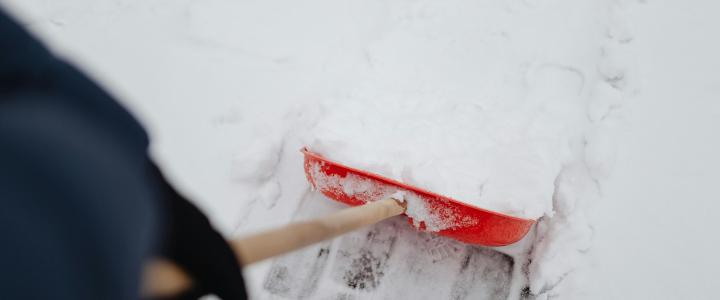
January 2024: SnowPro Tips for Homeowners – Shovel, Scatter and Sweep!
It’s the time of year when the sounds of snowplows greet you in the morning after an evening snowfall. You look out at your snowy driveway, put on your winter gear, grab a shovel and a bag of de-icing salt, and head outside to clear the snow and ice.
Unfortunately, de-icing salt is commonly made up of sodium (Na) and chloride (Cl) ions, and ultimately makes its way into nearby streams, rivers, lakes and ponds. This elevates the chloride concentrations, harming plants, fish and wildlife. There are currently over 50 waterbodies in the state of New Hampshire that have chloride impairments with levels exceeding standards set by the U.S. Environmental Protection Agency. Elevated sodium and chloride levels contaminate the drinking water supply of individual homes as well as large drinking water supply systems that serve New Hampshire communities. Contamination in drinking water from NaCl has increased by 150% over the last 30 years. Chloride is a permanent pollutant, and it only takes one teaspoon of de-icing salt to pollute up to five gallons of water.
There are many salt reduction practices that municipalities, the state Department of Transportation and commercial contractors can implement while maintaining roadways, parking lots and sidewalks during the winter season. But what about your own driveway and walkways? Here are some steps that you can take to reduce winter salt usage on your own property. Remember to shovel, scatter and sweep!
Shovel before applying
Clear snow from driveway and walkways before applying salt. The more snow that is removed manually, the less salt you will need to use.
Scatter the salt grains
When applying salt after clearing the snow, make sure to scatter and leave space between the grains. A 12-ounce coffee mug of salt is enough to treat a 20-foot driveway or 10 sidewalk squares. Remember, only treat the areas that are used regularly. If possible, avoid treating rarely used areas such as side door walkways.
Sweep up excess salt
After the ice on your driveway and walkways has melted, sweep up leftover salt. This will prevent the excess salt from being washed away into local surface waters and groundwater, preventing contamination as well as damage to vegetation and landscaped areas. The excess salt can be saved to use later and is also a good indicator that you can use less next time.
Hire a Green SnowPro certified professional
If you hire a contractor to manage your property, consider hiring a Green SnowPro certified professional. The NHDES Green SnowPro Program offers snow and ice management training and certification in salt reduction practices that prioritize public safety while mitigating salt usage. In return for their efforts, commercial salt applicators certified as Green SnowPro under RSA 489-C, and property owners or managers who hire them, are granted liability protection against damages arising from snow and ice conditions under RSA 508:22.
Small actions can have lasting impacts. Simple practices that reduce winter salt use help prevent increasing chloride concentrations, keeping New Hampshire waters healthy for future generations.
# # #




